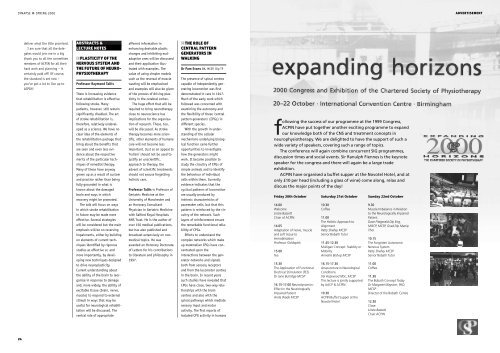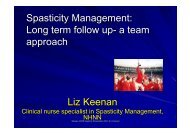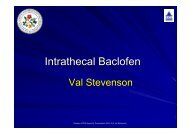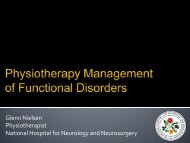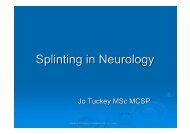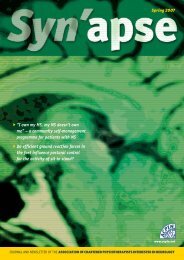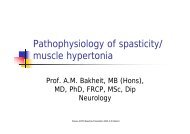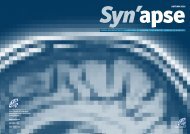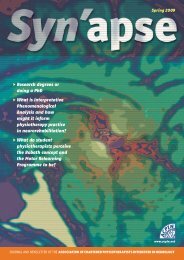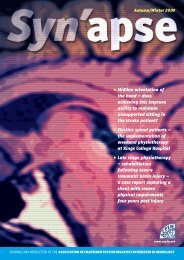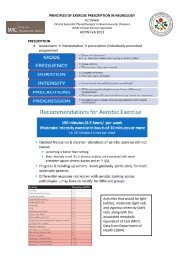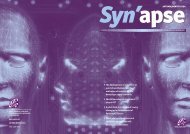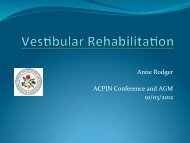SYNAPSE ● <strong>SPRING</strong> <strong>2000</strong>ADVERTISEMENTdeliver what the title promised.I am sure that all the delegateswould join me in a bigthank you to all the committeemembers of ACPIN for all theirhard work and planning – itcertainly paid off! Of course,the standard is set now –you’ve got a lot to live up toACPIN!ABSTRACTS &LECTURE NOTES■C PLASTICITY OF THENERVOUS SYSTEM ANDTHE FUTURE OF NEURO-PHYSIOTHERAPYProfessor Raymond TallisThere is increasing evidencethat rehabilitation is effectivefollowing stroke. Manypatients, however, still remainsignificantly disabled. The artof stroke rehabilitation is,therefore, relatively undevelopedas a science. We have noclear idea of the elements ofthe rehabilitation package thatbring about the benefits thatare seen and even less evidenceabout the respectivemerits of the particular techniquesof remedial therapy.Many of these have anywaygrown up as a result of customand practice rather than beingfully grounded in what isknown about the damagedbrain and ways in whichrecovery might be promoted.The talk will focus on waysin which stroke rehabilitationin future may be made moreeffective. Several strategieswill be considered but the mainemphasis will be on reversingimpairments, either by buildingon elements of current techniquesidentified by rigorousstudies as effective or, andmore importantly, by developingnew techniques designedto drive neuroplasticity.Current understanding aboutthe ability of the brain to reorganisein response to damageand, more widely, the ability ofexcitable tissue (brain, nerve,muscle) to respond to externalstimuli in ways that may beuseful for neurological rehabilitationwill be discussed. Thecentral role of appropriateafferent information inenhancing desirable plasticchanges and inhibiting maladaptiveones will be discussedand their application illustratedwith examples. Thevalue of using simpler modelssuch as the reversal of musclewasting will be emphasisedand examples will also be givenof the process of driving plasticityin the cerebral cortex.The huge effort that will berequired to bring neurotherapyclose to neuroscience hasimplications for the organisationof research. These, too,will be discussed. As stroketherapy becomes more scientific,other elements of humanecare will not become lessimportant. Just as an appeal to‘holism’ should not be used tojustify an unscientific,approach to therapy, theadvent of scientific treatmentsshould not excuse forgettingholistic care.Professor Tallis is Professor ofGeriatric Medicine at theUniversity of Manchester andan Honorary ConsultantPhysician in Geriatric Medicinewith Salford Royal HospitalsNHS Trust. He is the author ofover 150 medical publications,but has also published andbroadcast extensively on nonmedicaltopics. He wasawarded an Honorary Doctorateof Letters for his contributionsto literature and philosophy in1997.■C THE ROLE OFCENTRAL PATTERNGENERATORS INWALKINGDr Pam Evans BA, MCSP, Dip TPThe presence of spinal centrescapable of independently generatinglocomotion was firstdemonstrated in cats in 1947.Much of the early work whichfollowed was concerned withexamining the autonomy andthe flexibility of these ‘centralpattern generators’ (CPGs) indifferent species.With the growth in understandingof the cellularmechanisms underlying biologicalfunction came furtheropportunities to investigatehow the generators mightwork. It became possible tostudy the circuitry of CPGs ofsimple animals and to identifythe behaviour of individualcells within them. Currentlyevidence indicates that thecyclical patterns of locomotionare usually produced byintrinsic characteristics ofpacemaker cells, but that thispattern is reinforced by the circuitryof the network. Suchlayers of reinforcement ensurethe remarkable functional reliabilityof CPGs.Efforts to understand thecomplex networks which makeup mammalian CPGs have concentratedupon theinteractions between the generatornetworks and signalsboth from sensory receptorsand from the locomotor centresin the brain. In recent yearssuch studies have revealed thatCPGs have close, two-way relationshipswith the braincentres and also with thespinal pathways which mediatesensory input and motoractivity. The first reports ofisolated CPG activity in humansfollowing the success of our programme at the 1999 Congress,ACPIN have put together another exciting programme to expandour knowledge both of the CNS and treatment concepts inneurophysiotherapy. We are delighted to have the support of such awide variety of speakers, covering such a range of topics.The conference will again combine concurrent SIG programmes,discussion times and social events. Sir Ranulph Fiennes is the keynotespeaker for the congress and there will again be a large tradeexhibition.ACPIN have organised a buffet supper at the Novotel Hotel, and atonly £10 per head (including a glass of wine) come along, relax anddiscuss the major points of the day!Friday 20th October14.00WelcomeLinzie BassettChair of ACPIN14.05Adaptation of nerve, muscleand soft tissue toImmobilisationProfessor Goldspink15.00Tea15.30The Application of FunctionalElectrical Stimulation (FES)Dr Jane Burridge MCSP16.15-17.00 Neurodynamics-Effect in the NeurologicallyImpaired PatientAnita Wade MCSPSaturday 21st October10.30Coffee11.00The Holistic Approach toAlignmentPatty Shelley MCSPSenior Bobath Tutor11.45-12.30Mulligan Concept: Stability orMobilityAnnette Bishop MCSP16.15-17.30Acupuncture in NeurologicalConditionsVal Hopwood MSc, MCSPThis lecture is jointly supportedby AACP & ACPIN19.30ACPIN Buffet Supper at theNovotel HotelSunday 22nd October9.30Muscle Imbalance in Relationto the Neurologically ImpairedPatient.Dave Fitzgerald Dip Eng,MISCP, MCSP, Grad Dip ManipTher.10.15The Forgotten AutonomicNervous SystemPatty Shelley MCSPSenior Bobath Tutor11.00Coffee11.30The Bobath Concept TodayDr Margaret Mayston, PhD,MCSPDirector of the Bobath Centre12.30CloseLinzie BassettChair ACPIN24
SYNAPSE ● <strong>SPRING</strong> <strong>2000</strong>CONGRESS REVIEWShave also appeared.These experimental observationscould have importantimplications for therapists concernedwith the re-educationof walking. In the short termthey may pose more questionsthan they answer, but somequestions could form the basisof future clinical studies.Pam Evans has wide experienceboth as a clinician and as alecturer. She gained her MSc inphysiology in 1992 and hascontinued to research on apart-time basis in neurophysiologyin the field of motorcontrol. She is also a SeniorLecturer at the Faculty ofHealthcare Sciences, StGeorges Medical School andKingston University.■C THE USE OF THETREADMILL WITHNEUROLOGICALLYIMPAIRED ADULTSCatherine Ann Kendrick GradDip Phys SRP, MCSP.The use of the motorised treadmillwith neurological patientsis a developing field in neurologicalrehabilitation. Itfollows the task orientedapproach to skill acquisitionand can be used either on itsown as an exercise tool or withbody weight support (BWS) tore-educate gait.Many stroke patients arephysically deconditioned andfatigue easily. This furtherlimits functional mobility.Recent studies suggest thataerobic exercise will not onlyimprove cardiovascular functionbut may also improvemotor recovery. (Potempa1995, Macko 1997).The treadmill may thereforebe an appropriate tool toenable patients to exercise aerobicallyand additionallyprovide a task-orientedtraining for gait.Early treadmill studies werecarried out on cats followingspinal cord transection. Theanimals were trained on atreadmill with some of theirbody weight supported in orderto restore gait. (Barbeau1987). Later treadmill trainingwith BWS was shown to beeffective in re-educating gaitafter incomplete spinal cordinjuries (Barbeau 1992). Theanimal and spinal cord studiesboth support the existence ofthe interneuronal circuitsresponsible for locomotion.More recent studies haveinvestigated the use of BWSand the treadmill with earlystroke patients in optimisinggait recovery (Visintin 1998).The research I am currentlyinvolved with is investigatingboth the effects of exercise onfunctional mobility and the useof BWS and the treadmill withchronic stroke patients.The use of the treadmill withneurological patients has manypotential benefits for a varietyof patients but requires furtherinvestigation to clarify its rolein physiotherapy practice.Catherine Ann Kendrick hasin the last year taken on apart-time research post fundedfor two years by the StrokeAssociation to investigate theuse of treadmill training inchronic stroke patients. This iscomplimented by a part-timeclinical position in theRegional Rehabilitation Unit,Addenbrookes Hospital.■C PHYSIOTHERAPY FORPEOPLE WITHPARKINSON’S DISEASE– DESCRIBING UKPRACTICEDr Ann Ashburn, BrendaLovgreen, Diana JonesAn investigation of best practicephysiotherapy inParkinson's disease in the UKhas been undertaken by a teamof clinical and academic physiotherapists.The project aimswere to develop a consensuson service delivery and treatmentframeworks, and providea baseline model of practice toguide future research. Stage Iwas a Delphi survey of specialistphysiotherapists (SeniorI or above and at least 2 yearsexperience working with theclient group, a current caseload).Statements relating tocontext, reasons, actions, andeffects of physiotherapy wererated on a scale of 1-9 byn=49. Specialists (> 20 yearspost qualification; with 1Oyears treating the client group,with 11 patients a month)worked mostly in Care of theElderly (60%). Marked variationwas evident in actual practicecontexts, and early referral wasrare. However there was strongconsensus on the elements ofan optimal context whichincluded early referral, and thereason for physiotherapy – tomaximise functional ability andminimise secondary complicationsthrough movementrehabilitation within a contextof education and support forthe whole person. In theactions domain an eclecticapproach to treatment, withtechniques drawn from a rangeof approaches, was consideredto have the best outcomes.Effects should be measured ata functional level and relate tospecified aims of treatment.Stage 2 involved case studiesof nine best practice sites.Direct case study of three sitesinvolved site visits and face toface interviews with clinicians,managers, multidisciplinaryteam members, patients andcarers. Indirect case study ofsix sites involved telephoneinterviews with clinicians andmanagers. The foci of Stage 2were clinical activity, servicestructure and patient views.Final results in all three areaswill be discussed. The projecthas been sponsored by GlaxoWellcome under the auspices ofthe Parkinson’s DiseaseSociety. Plans to extend theproject into Europe will be presented.Dr Ann Ashburn is a SeniorLecturer in Rehabilitation atthe University of Southampton.She is one of a team of physiotherapistsinvestigating bestpractice for people withParkinson’s disease in the UK.Brenda Lovgreen is a SeniorLecturer at the ManchesterSchool of Physiotherapy. She isa founder member of thePhysiotherapy ResearchSociety.Diana Jones is a ResearchPhysiotherapist at theInstitute of Rehabilitation,University of Northumbria atNewcastle. She will be thephysiotherapist on TheCochrane CollaborationMovement Disorders Groupteam undertaking a review ofthe paramedical professionsand Parkinson’s disease.■C IS SPASTICITY JUSTHYPERREFLEXIA?Dr John Rothwell BA, PhDSpasticity is both the name ofa syndrome (increased tone,increased flexor reflexes andreduced motor performance)and a description of a particulartype of muscle tone. Ishall consider only the latter,and describe to what extentstretch reflexes, increasedbackground muscle contractionand changes in mechanicalproperties of muscle all contributeto the clinicalimpression of increased resistanceto movement.The sensitivity of the stretchreflex is controlled by activityin descending systems from thebrainstem reticular formation.When these are deprived ofinput from the cerebral motorareas, stretch reflexes areenhanced. Classically,enhanced stretch reflexes arethought to interfere with voluntarymovement by, forexample, producing inappropriateactivity in antagonistmuscles during contraction ofthe agonist. However, this maynot be the whole story.Sometimes stretch reflexes areonly enhanced when examinedat rest. Stretch reflexes elicitedduring voluntary movementmay be relatively normal. Theoutcome is that there is littlereflex interference withongoing movement. The mostlikely cause of disordered voluntarymovement is notenhanced tone, but inappropriatelyfocused commands fromthe central nervous system.Finally it is worth consideringthe possible benefits ofincreased muscle tone. It canstiffen the legs to bear weight.In addition, increased reflexfeedback may even be useful tosupplement voluntary contractionsthrough spinal reflexloops.Dr John Rothwell is Head ofMovement Disorders, MRCHuman Movement and BalanceUnit, Institute of Neurology,Queen Square, London. He hastwo areas of special interest;transcranial magnetic stimulationand the pathophysiologyof movement control inpatients with diseases of thebasal ganglia. He is deputyeditor of Brain, NeurophysiologyEditor for ExperimentalBrain Research and Editor forthe Journal of Physiology.■C PHYSIOTHERAPYMANAGEMENT OFESTABLISHEDSPASTICITYSue Edwards FCSPAbstract with additional lecturenotes.Increased tone is a commonmanifestation of neurologicalpathology and is often a keydeterminant of the severity ofdisability. The physiologicaldefinition of spasticity, that of‘a motor disorder characterisedby a velocity dependentincrease in tonic stretchreflexes with exaggeratedtendon jerks’ (Lance 1980) hassurvived for nearly twentyyears and yet has little relevancein clinical practice ormore importantly to thepatient.So what are we treating?Hypertonia is a combination ofboth neural and non-neuralcomponents. The centralnervous system (CNS) knowshow to organise and controlmovements, and so changedmotor patterns should be consideredadaptive rather thanpathological (Latash and Anson1996). Neural aspects of toneare described as positiverelease phenomenon or anacquired response to CNSdamage. The presentation ofhypertonia is different betweengross cerebral pathology suchas in head injury and morelocalised lesions as occurs withcerebrovascular accident. Thereis also a difference betweencerebral and spinal hypertonus.Non-neural aspects of toneinclude the intrinsic stiffness ofthe muscle structure whichoccurs, described asthixotrophy, and stiffness andcontracture in external structuressuch as connective tissue.2627


